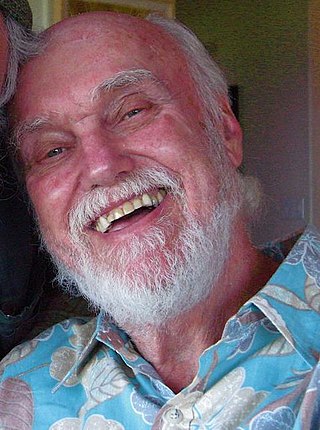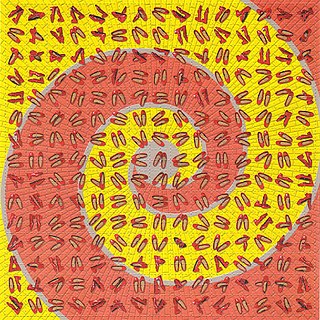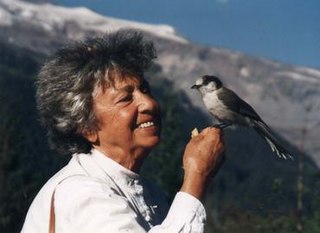
Timothy Francis Leary was an American psychologist and author known for his strong advocacy of psychedelic drugs. Evaluations of Leary are polarized, ranging from bold oracle to publicity hound. He was "a hero of American consciousness", according to Allen Ginsberg, and Tom Robbins called him a "brave neuronaut".

Psychedelia usually refers to a style or aesthetic that is resembled in the psychedelic subculture of the 1960s and the psychedelic experience produced by certain psychoactive substances. This includes psychedelic art, psychedelic music and style of dress during that era. This was primarily generated by people who used psychedelic drugs such as LSD, mescaline and psilocybin and also non-users who were participants and aficionados of this subculture. Psychedelic art and music typically recreate or reflect the experience of altered consciousness. Psychedelic art uses highly distorted, surreal visuals, bright colors and full spectrums and animation to evoke, convey, or enhance the psychedelic experience. Psychedelic music uses distorted electric guitar, Indian music elements such as the sitar, tabla, electronic effects, sound effects and reverb, and elaborate studio effects, such as playing tapes backwards or panning the music from one side to another.

Ram Dass, also known as Baba Ram Dass, was an American spiritual teacher, guru of modern yoga, psychologist, and writer. His best-selling 1971 book Be Here Now, which has been described by multiple reviewers as "seminal", helped popularize Eastern spirituality and yoga in the West. He authored or co-authored twelve more books on spirituality over the next four decades, including Grist for the Mill (1977), How Can I Help? (1985), and Polishing the Mirror (2013).

The psychedelic drug lysergic acid diethylamide (LSD) was first synthesized on November 16, 1938, by the Swiss chemist Albert Hofmann in the Sandoz laboratories in Basel, Switzerland. It was not until five years later on April 19, 1943, that the psychedelic properties were found.

The Harvard Psilocybin Project was a series of experiments in psychology conducted by Timothy Leary and Richard Alpert. The founding board of the project consisted of Leary, Aldous Huxley, David McClelland, Frank Barron, Ralph Metzner, and two graduate students who were working on a project with mescaline.
The Brotherhood of Eternal Love was an organization of drug users and distributors that operated from the mid-1960s through the late 1970s in Orange County, California. They were dubbed the Hippie Mafia by the police. They produced and distributed drugs in hopes of starting a "psychedelic revolution" in the United States.

Nicholas Sand was a cult figure known in the psychedelic community for his work as a clandestine chemist from 1966 to 1996 for the Brotherhood of Eternal Love. Sand was part of the League for Spiritual Discovery at the Millbrook estate in New York, has been credited as the "first underground chemist on record to have synthesized DMT" and is known for manufacturing large amounts of LSD.
Michael Hollingshead (?–1984?) was a British researcher who studied psychedelic drugs, including psilocybin and LSD, at Harvard University in the mid-20th century. He was the father of comedian Vanessa Hollingshead. He evangelized the use of LSD to many notable figures.
Ego death is a "complete loss of subjective self-identity". The term is used in various intertwined contexts, with related meanings. Jungian psychology uses the synonymous term psychic death, referring to a fundamental transformation of the psyche. In death and rebirth mythology, ego death is a phase of self-surrender and transition, as described by Joseph Campbell in his research on the mythology of the Hero's Journey. It is a recurrent theme in world mythology and is also used as a metaphor in some strands of contemporary western thinking.

USCO was an American media art collective in the 1960s, founded by Gerd Stern, Michael Callahan, Steve Durkee, Judi Stern, and Barbara Durkee in New York. The name USCO is an acronym for Us Company or the Company of Us. The collective was most active during the years 1964–66. USCO exhibited in the United States, Canada, and Europe, and is considered a key link in the development of expanded cinema, visual music, installation art, multimedia, intermedia, and the Internet. In addition, USCO's strobe environments heralded new media art.
Walter Norman Pahnke was a minister, physician, and psychiatrist most famous for the "Good Friday Experiment", also referred to as the Marsh Chapel Experiment or the "Miracle of Marsh Chapel".
"Turn on, tune in, drop out" is a counterculture-era phrase popularized by Timothy Leary in 1966. In 1967, Leary spoke at the Human Be-In, a gathering of 30,000 hippies in Golden Gate Park in San Francisco and phrased the famous words, "Turn on, tune in, drop out". It was also the title of his spoken word album recorded in 1966. On this lengthy album, Leary can be heard speaking in a monotone soft voice on his views about the world and humanity, describing nature, Indian symbols, "the meaning of inner life", the LSD experience, peace, and many other issues.

The Zihuatanejo Project was a psychedelic training center and intentional community created during the beginning of the counterculture of the 1960s by Timothy Leary and Richard Alpert under the umbrella of their nonprofit group, the International Federation for Internal Freedom (IFIF). The community was located in Zihuatanejo, Guerrero, Mexico, and took up residence at the Hotel Catalina in the summers of 1962 and 1963.
Don Lattin is an American journalist and the author of six published books, including The Harvard Psychedelic Club and Changing Our Minds — Psychedelic Sacraments and the New Psychotherapy Lattin’s work has appeared in many U.S. magazines and newspapers, including the San Francisco Chronicle where he worked for two decades as a staff writer covering religion, spirituality and psychology.
The following is a list of works by Timothy Leary. The majority of Leary's works were put into the public domain by his estate in 2009.

The Original Kleptonian Neo-American Church (OKNeoAC), mostly shorted Neo-American Church, is a religious organization based on the use of psychedelic drugs as a sacrament.
The psychedelic churches exist to promote and defend the psychedelic religion, a religion which sees in the transcendental experience produced by the sacred substances the key to understanding life and improving the condition of man on earth.
Greta Loebl Schreyer, born Greta Loebl, was an Austrian-American, Jewish jewelry designer and painter. She survived the Holocaust and died in New York City.
The Hitchcock Estate in Millbrook, New York is a historic mansion and surrounding grounds, associated with Timothy Leary and the psychedelic movement. It is often referred to in this context as just Millbrook; it is also sometimes called by its original name, Daheim.

Nina Graboi was a Holocaust survivor, artist, writer, spiritual seeker, philosopher, and influential figure in the sixties psychedelic movement. After fleeing the Nazis in Europe and spending three months in a detention camp in North Africa, she and her husband came to America as refugees. As a close friend and colleague of Timothy Leary's and Richard Alpert's, she was co-founder and director of the League for Spiritual Discovery's New York Center during the psychedelic era. The center was the first LSD-based meditation center in Manhattan. She also worked closely with Jean Houston, Abraham Maslow, Stanley Krippner, and Alan Watts.
Entheogenic drugs have been used by various groups for thousands of years. There are numerous historical reports as well as modern, contemporary reports of indigenous groups using entheogens, chemical substances used in a religious, shamanic, or spiritual context.










